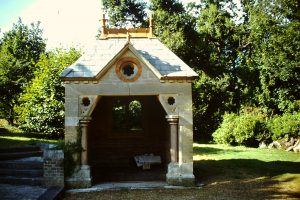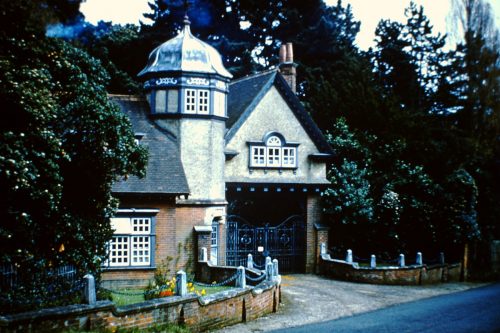Ryde Architecture
WOODLANDS VALE
The Isle of Wight residence of General the Hon. Somerset John Gough Calthorpe and his wife the Hon. Mrs. Eliza Maria Calthorpe. They were married 28th January 1862 at the Parish Church St. George’s Hanover Square, Westminster. She was the only child of Captain Frederick Chamier, R.N. and widow of Captain Frederick Crew.
 There were many events held at Woodlands Vale, a lot of garden parties, when the elite of the town and affluent visitors from the mainland were invited to partake of refreshments provided in a tent on the lawn, and tea was served in the drawing room in the house. Among the pictures in this room, was one of melancholy interest. General Calthorpe saw service all through the Crimean War, and was the witness of the foundering of the auxiliary screwship “Prince.” This vessel went to the Crimea with great coats, blankets, and comforts for the troops. The ship foundered and added to the fearful privations which our troops suffered. General Calthorpe sketched the incident, which he personally witnessed, and from his sketch a painting had been made.
There were many events held at Woodlands Vale, a lot of garden parties, when the elite of the town and affluent visitors from the mainland were invited to partake of refreshments provided in a tent on the lawn, and tea was served in the drawing room in the house. Among the pictures in this room, was one of melancholy interest. General Calthorpe saw service all through the Crimean War, and was the witness of the foundering of the auxiliary screwship “Prince.” This vessel went to the Crimea with great coats, blankets, and comforts for the troops. The ship foundered and added to the fearful privations which our troops suffered. General Calthorpe sketched the incident, which he personally witnessed, and from his sketch a painting had been made.
At these garden parties all the guests enjoyed the beautiful grounds which were laid out in Italian style, with pleasant terraces, shady vine-covered walks, delightful lawns, and flower beds, while in the distance between magnificent trees, peeps the blue Solent with its forts, ships, yachts, &c. A Military Band was always in attendance at the functions. All this was made doubly pleasant by the kindly and courteous style in which the gallant general and his charming wife and daughter welcomed their numerous guests.

 In 1895 guests who had the opportunity of visiting Woodlands Vale, greatly admired the improvements which had been effected. The ground sloped rapidly towards the sea, and General Calthorpe had raised a great portion of it by an additional ornamental terrace north of the house. In the centre of this terrace, surrounded by a beautiful tosselated pavement, a miniature artificial lake had been constructed. This was spanned by a high bridge of elegant design, at the top of which was a pagoda, or more properly speaking summer-house. Gen. Calthorpe had adopted the idea of Japanese landscapes, but carried it out in a style so much more graceful and picturesque. In appearance it is something like the portico of an ancient temple. From the elevated shelter of the summer-house beautiful views of the grounds are obtained. The shaded walks with trellis work on which hang grape vines, roses and other creeping plants, completely shading from the sun.
In 1895 guests who had the opportunity of visiting Woodlands Vale, greatly admired the improvements which had been effected. The ground sloped rapidly towards the sea, and General Calthorpe had raised a great portion of it by an additional ornamental terrace north of the house. In the centre of this terrace, surrounded by a beautiful tosselated pavement, a miniature artificial lake had been constructed. This was spanned by a high bridge of elegant design, at the top of which was a pagoda, or more properly speaking summer-house. Gen. Calthorpe had adopted the idea of Japanese landscapes, but carried it out in a style so much more graceful and picturesque. In appearance it is something like the portico of an ancient temple. From the elevated shelter of the summer-house beautiful views of the grounds are obtained. The shaded walks with trellis work on which hang grape vines, roses and other creeping plants, completely shading from the sun.
Going up one of the walks on the eastern side of the house a novel feature, never before introduced into England, is encountered an exact copy of one of the wooden gateways which are to be seen in front of every temple in Japan. Here the ornaments of the terrace are distinctly Japanese in style. The conservatory, which used to be on the east side of the house, had been removed, and its place taken by a new billiard room, and new stable accommodation had also been erected near the road. Many who pass by on the highroad hardly realise what a charming country seat nestles behind the trees which skirt the road just past Cherrygin.
Lieut.-General the Right Hon. Seventh Lord Calthorpe died at Woodlands Vale on 18th November 1912. More about Lord Calthorpe here
Lady Eliza Maria Calthorpe died at Woodlands Vale on 26th August 1919. More about Lady Calthorpe here
Sources: Images RSHG Archive Roy Brinton Collection, Isle of Wight Observer & The Peerage

